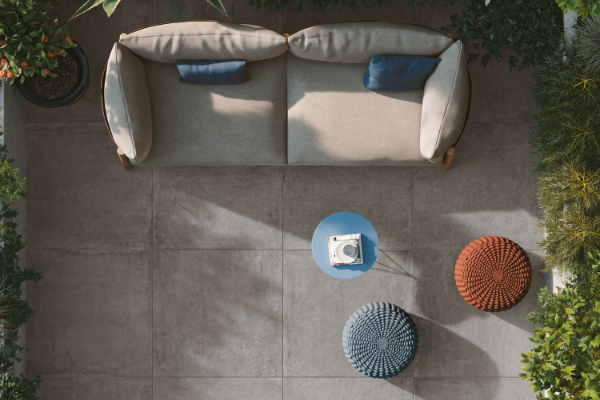
Are you fed up with the unsightly grey concrete slab on your terrace that’s difficult to clean? Are you ready to start tiling your outdoor space? Here’s everything you need to know to get the job done right.
What type of outdoor tiling should be laid on a concrete slab?
Given their exposure to the elements and temperature variations, outdoor tiles need to be more resistant than those laid indoors. Whether it’s a terrace for professional use or a private outdoor space, tiles have to withstand a lot of foot traffic and abrasion (moving tables and chairs, heels…). Follow the UPEC classification and choose the model whose standard corresponds to your needs.
Ultra-resistant anti-slip porcelain stoneware tiles can be laid on different types of flooring, including concrete slabs, using a specific method. Novoceram, for example, offers a number of premium-quality outdoor products that imitate natural, eco-responsible materials (wood, Bali stone, etc.).
Things to consider before laying tiles on concrete
Have you chosen and bought your tiles? Good news, but don’t start laying them just yet, or you’ll have to start all over again next season.
Condition of the concrete slab
A concrete slab is made up of sand, gravel, cement and water. This structural element, reinforced by a metal framework to create a load-bearing floor or stabilise a space, is generally poured in a rough manner. A slab may or may not be covered with a concrete screed, which has a smoother surface that does not contain gravel.
The most important stage is therefore to check and prepare the surface on which you are going to lay your tiles. Outside, a terrace may just have been bricked up with a concrete slab, without a concrete screed. With or without a screed, the surface will need to be carefully examined, especially if it has been left unfinished for several years. To lay tiles on a concrete slab, it must be :
- Covered with a smooth screed with a sound surface (no cracks, no mould, etc.) and perfectly clean (no leaves, no dust, etc.). The floor must be cleaned and, if necessary, levelled to add a finishing coat to smooth out the rough masonry surface.
- Be perfectly stable and dry. If you’ve just poured your slab, you’ll need to wait at least 1 month before tiling it.
- Be flat with a slope of 1.5% so that rainwater can drain off easily once the terrace has been tiled.
No tile can be laid on an inadequate surface and, above all, remain permanently fixed.
Choose the right material
Once the surface of the slab is ready, you can start laying your tiles, which must of course be designed for outdoor installation. To do this, choose the right equipment (spacers, trowel, notched trowel, mallet, electric tiler, level, etc.). Don’t neglect protective equipment such as gloves and goggles when cutting tiles.
Above all, choose your adhesive mortar carefully (C2, C2 S1 or C2S2), as well as your grouting mortar, so that your covering is resistant to damp. Don’t hesitate to ask the experts at Novoceram or other professionals for advice. They will also be able to advise you on the quantity you need (around 5 kg of adhesive per m² for a double glue application, especially outdoors).
How do I lay tiles on a terrace?
For your terrace, as for all the concrete tiles in your outdoor spaces, there are a number of steps to follow when laying your tiles.
Choosing how to lay your tiles
The most traditional method is glue-down installation, which guarantees the durability and aesthetic appeal of the tiles. Laying outdoor tiles on a concrete slab is based on double gluing, which ensures optimum adhesion even under heavy stress. This technique involves gluing both the back of the tiles and the floor. Some professionals also use sealed laying, which involves gluing the tiles directly to the concrete slab or screed using a thicker mortar. This technique, which requires masonry skills, makes it possible to correct certain surface defects.
Choosing the tile layout
You can give free rein to your imagination by combining tiles in different formats. If you have chosen tiles of the same size, you can play around with their layout: straight (aligned against a wall), diagonal or staggered (parquet-style).
Make careful expansion and separation joints
These joints between the tiles and between the tiles and the building reduce stress and stabilise the elements. They help to avoid the problems associated with the natural expansion and contraction of materials, which occur tenfold outdoors. This essential outdoor stage ensures that the flooring is watertight, and prevents cracks and untimely, premature delamination of the tiles. Ideally, this fairly technical stage should be carried out by a professional.
FAQ laying tiles on concrete
Is it possible to lay tiles on a slab without a concrete screed?
A rough concrete slab has too many irregularities for tiles to be laid directly on it. Whatever type of tiling you choose (porcelain stoneware, imitation wood/stone, etc.), it’s always important to lay a concrete screed or levelling compound beforehand.
How do I know how much tiling to lay on a concrete slab?
Start by measuring the slab you want to cover. You’ll only be able to work out how much to buy once you’ve decided on the tile format and the type of installation you want. Always allow for 10% more tiles in case of breakage.
Who can lay outdoor tiles on a concrete slab?
You can do the laying if your concrete slab is in good condition, has a clean even surface and you follow all the steps. You’ll also need to have the time to carry out the work, not be afraid of physical labour and be very meticulous about making watertight joints. To avoid unpleasant surprises (delamination, seepage, etc.), we recommend that you always call in a professional to lay exterior tiles.
If you have any doubts (choice of tiles, laying techniques, etc.), don’t hesitate to ask the Novoceram experts for advice.

 Listen
Listen



